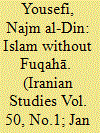|
|
|
Sort Order |
|
|
|
Items / Page
|
|
|
|
|
|
|
| Srl | Item |
| 1 |
ID:
151450


|
|
|
|
|
| Summary/Abstract |
This article examines some manuscripts of the so-called “Anonymous Histories of Shah Esmāʿil” with a view to answering the question: How did people in post-1514 Iran remember the Battle of Chālderān? After a brief examination of these manuscripts, the article focuses on three moments of the battle—the Safavid council of war, Esmāʿil’s clash with Malquch-oghli, and the Ottoman cannonade—to explore the ways in which popular memory embellished and altered the events we know from the official histories. Such changes reveal that the loss at Chālderān may have marked the end of Shah Esmāʿil’s aura of invincibility, but not of his larger-than-life image in the minds of his countrymen.
|
|
|
|
|
|
|
|
|
|
|
|
|
|
|
|
| 2 |
ID:
151453


|
|
|
|
|
| Summary/Abstract |
The dative case in Vafsi appears in three structures: (a) the case of the experiencer in sensory verbs, (b) the case of the indirect object (IO), and (c) the case of the object of the preposition /da/ (to), or the preposition /az/ (to), or the enclitic /-o/ (to), or the object of the postposition /rā/ (for). In Vafsi, as in many other Indo-European languages, sensory verbs necessitate the emergence of quirky subjects which have the experiencer function and are dative case marked. In order to analyze the dative case marking in Vafsi using optimality theory, this article uses the faithfulness constraint of faith-lex and the markedness constraint hierarchy of *ERG>>*DAT>>*ACC>>*NOM. Vafsi always allocates the dative case to the IO of the ditransitive verbs. This phenomenon is illustrated by use of an optimality theory (OT) tableau. Some Vafsi ditransitive verbs dative case mark the IOs using adpositions. If so, Vafsi differential adpositional case marking (DACM) will rule, as the IOs are objects of adposition (OAs) simultaneously.
|
|
|
|
|
|
|
|
|
|
|
|
|
|
|
|
| 3 |
ID:
151452


|
|
|
|
|
| Summary/Abstract |
From 1928 to 1932 the Pahlavi regime of Iran negotiated with the Anglo-Persian Oil Company (APOC) to revise the D’Arcy Concession. These negotiations, conducted by ‘Abd al-Hosayn Teymurtāsh and the chairman of APOC Sir John Cadman, ended in failure when Rezā Shah unilaterally cancelled the D’Arcy Concession in November 1932. This article argues that “equitability” was the goal of the negotiations. An agreement was ultimately impossible to reach, due to differing ideas on either side regarding what was equitable, changes in the international oil economy and instability within Iran itself, leading to an unequal agreement in April 1933 that confirmed APOC’s long-term security but served only the short-term needs of Iran.
|
|
|
|
|
|
|
|
|
|
|
|
|
|
|
|
| 4 |
ID:
151448


|
|
|
|
|
| Summary/Abstract |
This paper seeks to advance the existing scholarship on Persian secretary and belles-lettrist, ʿAbd Allāh Ibn al-Muqaffaʿ (d. 139/757) and his Risāla fī ’l-Ṣaḥāba (Epistle Concerning the Entourage). It argues that the Risāla, addressed to the second Abbasid caliph al-Manṣūr, set out to tackle the political ills of the caliphate, especially the crisis of political legitimacy. As the first documented articulation of the Islamic polity, the Risāla made a series of recommendations, including a proposal for legal codification that attempted to reinvent the caliphate by reuniting the institution's political and legal authority at the expense of private jurists (fuqahāʾ). The paper illustrates how Ibn Muqaffaʿ’s solution relied on a creative integration of Iranian and Islamic ideas of statecraft and legitimate rule. Ironically, this creative integration may have played a part in the Risāla’s failure to garner necessary support to effect change.
|
|
|
|
|
|
|
|
|
|
|
|
|
|
|
|
| 5 |
ID:
151451


|
|
|
|
|
| Summary/Abstract |
This essay is the full account, the first in English, of the correspondence between the Russian general, Paul Tsitsianov, and the governor of the khanate of Ganjeh, Javād Khān Qajar. Drawing on contemporary Russian and Iranian records, it includes a daily account of Tsitsianov’s preparation, siege and the storming of the fortress of Ganjeh, which led to the First Russo-Iranian War (1804–13). The essay further includes two special maps—the first is the map of the South Caucasus in 1800 and the route of the invasion; while the second is based on a rare Russian military map that reveals the siege and storming of the fortress.
|
|
|
|
|
|
|
|
|
|
|
|
|
|
|
|
| 6 |
ID:
151449


|
|
|
|
|
| Summary/Abstract |
This paper is a monographic study of the illustrated copy of Ṣafvat al-Ṣafā, the life of Shaykh Ṣafī al-Dīn, by Ismāʿil bin Bazzāz, completed in Shaʿbān 990/September 1582 in Shirāz. It begins by giving information on the original text and its sources; then examines the unique illustrated copy. The features of the illustrated Ṣafvat al-Ṣafā are discussed while each of the fourteen images are explored in terms of the text-image relationship. The themes are also briefly analyzed according to a stylistic and iconographical approach in order to further exhibit the manuscript's uniqueness. The article concludes by emphasizing the significance of this copy at the Aga Khan Museum collection regarding its general condition, the illustration cycle and its records.
|
|
|
|
|
|
|
|
|
|
|
|
|
|
|
|
|
|
|
|
|